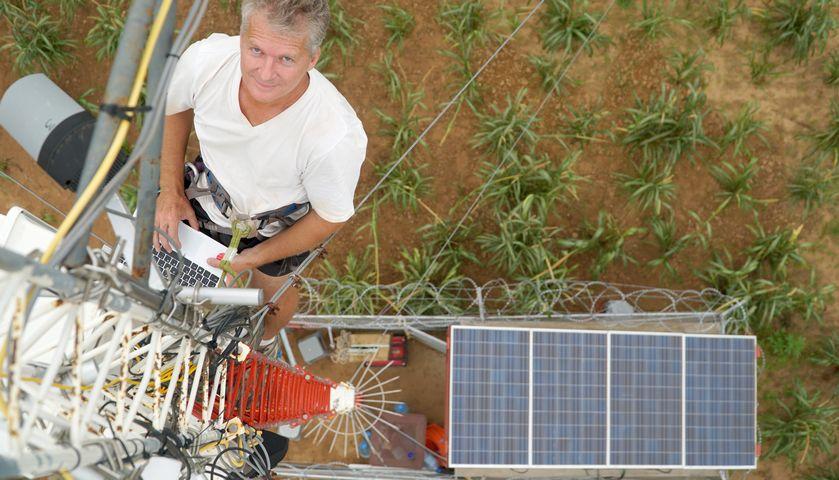- Home
- Work with us
- Open science
- CIRAD open infrastructures
- Tropical forest ecosystem observation
System for observing the functioning of tropical forest and plantation ecosystems

A CIRAD researcher on the Faidherbia-flux platform's flow tower in Senegal © V. Bonneaud, CIRAD
The six tropical sites are intended to offer case studies in three types of ecosystems: natural tropical rainforest in French Guiana and Thailand, industrial eucalyptus plantations in Brazil, a coffee-based agroforestry ecosystem in Costa Rica, rangelands created by deforestation in French Guiana and grazed an nual crops in Senegal.
They are also intended to be part of regional networks (in a continental context) and thus to broaden the French Observatory's possibilities for international cooperation.
Paracou European tropical research station
Studies and modelling of how the tropical rainforest of French Guiana functions, its biodiversity, couplings between water, carbon and nutrient cycles, and its response to manmade disturbance.
The station benefits from its proximity to other technical installations.
EUCFLUX forest experimentation and observation platform - Itatinga workshop site - Brazil
This network studies and models fast-growing eucalyptus stand functioning, couplings between water, carbon and nutrient cycles, and response to manmade disturbance, spatializes models using soil maps, satellite imagery and weather data, and assesses the environmental impact and sustainability of plantations (impact on water resources, soil fertility, the region's climate).
> More about the IN-SYLVA France infrastructure
Rubberflux forest experimentation and observation platform - Thailand workshop site
Rubberflux is an experimental site on a rubber plantation. Its main aims are:
- To study and model water and carbon flows within a productive rubber plantation
- To study carbon stock dynamics and distribution as a result of tree tapping and environmental conditions (climate, soil).
The site provides scientists with the following:
- In situ ecosystem experimentation services
- Instruments for long-term ecosystem monitoring and in situ measurement of environmental parameters
- Equipment and tools for collecting samples and data on the ecosystems studied.
> More info on the GIP-ECOFOR website
MataDiv/MataFlux forest experimentation and observation platform
MataDiv is a tree diversity experimental platform aiming to improve our understanding of how restored forests within the Atlantic tropical forest (Mata Atlântica) ecosystem in Brazil function in the light of climate change. It is coupled with the MataFlux flow tower, installed in 2020, which measures water, carbon and energy cycles using the Eddy-covariance technique and soil water monitoring.
> More info on the Treedivnet website
Faidherbia-flux agro-silvo-pastoral experimentation and observation platform - Senegal workshop site
Faidherbia-flux studies sustainable intensification of agro-silvo-pastoral systems, and particularly the role of herds and annual crop management practices, on ecosystem services and greenhouse gas flows and balances.
> More info on the Agroforestry Systems in West Africa (AGRAF) website
Greenhouse gases and carbon in grassland in French Guiana - CARPAGG
The CARPAGG platform studies soil carbon storage potential in grasslands resulting from deforestation, to establish carbon balances and other greenhouse gas balances.
























